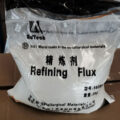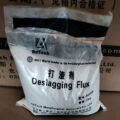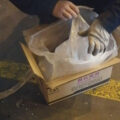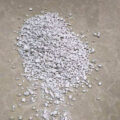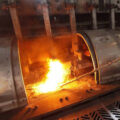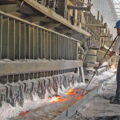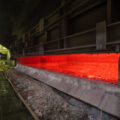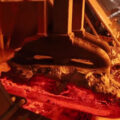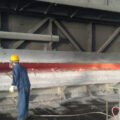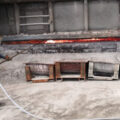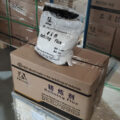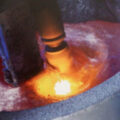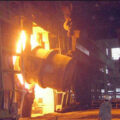Commercially used aluminum metal comes from two sources: either pure aluminum extracted from alumina (called primary aluminum), or metal obtained through the recycling of scrap from many sources (called secondary aluminum). In both cases, the metal refining is necessary before it can be used for manufacturing purposes.
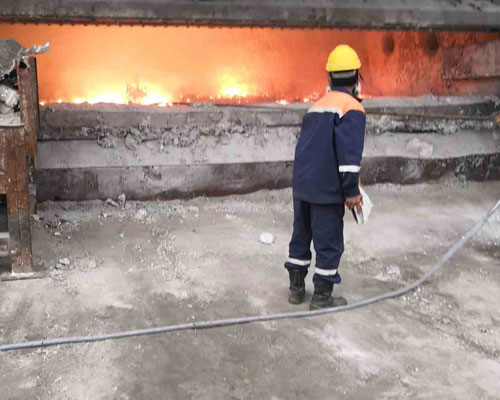
Oxides form scum, hydrogen is dissolved in metal, and its solubility increases with temperature. Unless removed, the dissolved gas will cause cracks in the final casting as it cools. Another major problem is that impurity elements must be completely removed from the molten metal or at least to a very low predetermined level.
In the aluminum and aluminum alloy industry, the common practice is to pass chlorine through the molten metal to remove the dissolved gas and to further free the metal from pores, oxide inclusions and other impurities. This method, called fluxing or degassing, usually uses full strength, that is, 100% concentration of chlorine. Nitrogen can also be used to degas aluminum.
The process of bringing aluminum into contact with reactive chlorine-containing vapor is commonly referred to as aluminum chloride. Through this process, impurity metals and hydrogen are removed. Magnesium and sodium are converted to chlorides, so they can be removed from the molten metal surface as aluminum slag.
Generally, the treatment of aluminum is performed by bubbling chlorine gas into the molten metal while bubbling it into the molten metal. A chemical reaction occurs between molten metal and chlorine to form chloride, which rises to the surface of the metal in the form of scum, consisting of metal chloride, trapped aluminum particles and alumina. One disadvantage of this method is the low utilization efficiency of chlorine. In addition, during processing, a considerable amount of aluminum is lost from the molten bath in the form of aluminum chloride.
The excessive amount of chlorine used causes two problems. Part of the chlorine is lost in the form of aluminum chloride. Hydrolysis occurs after contact with atmospheric water, generating hydrochloric acid and very fine aluminum hydroxide or oxide fumes. These two factors together constitute a huge air pollution problem. Although the acid can be removed fairly effectively in the exhaust port with a suitable water washing system, the alumina dust is very small, less than 2 microns, so it is difficult to remove. Secondly, gaseous chlorine is lost from the melt and can only be removed from the flue gas by some form of reaction system.
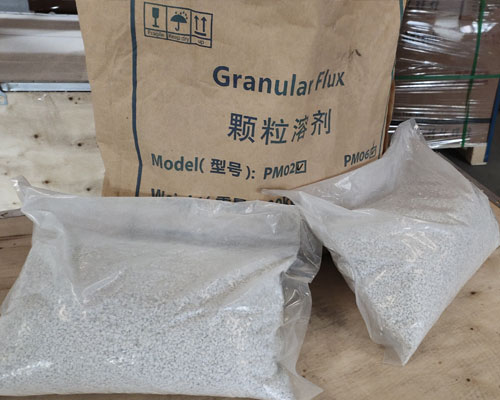
Metal Refining Method
AdTech provides the improved aluminum metal refining methods, include flux refining and online degassing.
Flux Refining
AdTech granular flux is mainly used to remove the hydrogen and floating oxide slag in the aluminum liquid, so that the aluminum liquid is more pure and has the function of a slag remover. In the refining process, the refining agent can reduce smoke and dust, reduce combustion loss, and be environmentally friendly and economical.
The jet enters the molten aluminum uniformly under the action of the carrier gas (N 2 or Ar). The physical and chemical changes of the molten aluminum form countless small bubbles that are in full contact with the molten aluminum, and separate [H] and others in the molten aluminum harmful gas. At the same time, certain substances contained in the refining agent can strongly adsorb and melt the oxides and suspended matter in the melt, and adhere to the bubbles. As the bubble rises, it is brought to the surface of the molten aluminum to achieve the purpose of purification, such as degassing and slag removal.

Online Degassing Method
The online degassing unit uses nitrogen as a degassing agent, which has no pollution to the environment and no reaction with molten aluminum. The hydrogen dissolved in the molten material diffuses into the rising bubbles of the flux gas and is transported to the surface of the molten material.
Oxide and other non-metallic inclusions are mainly removed by flotation, because small inert bubbles will attach themselves to the oxide and then float to the surface of the molten aluminum. The principles that apply to hydrogen removal also apply to oxide removal.
The bubbles of the inert gas are smaller and the residence time in the molten metal is longer. This ensures a large surface contact area between the inert gas bubbles and the molten metal, thus ensuring a higher mass transfer coefficient relative to the diffusion layer.

